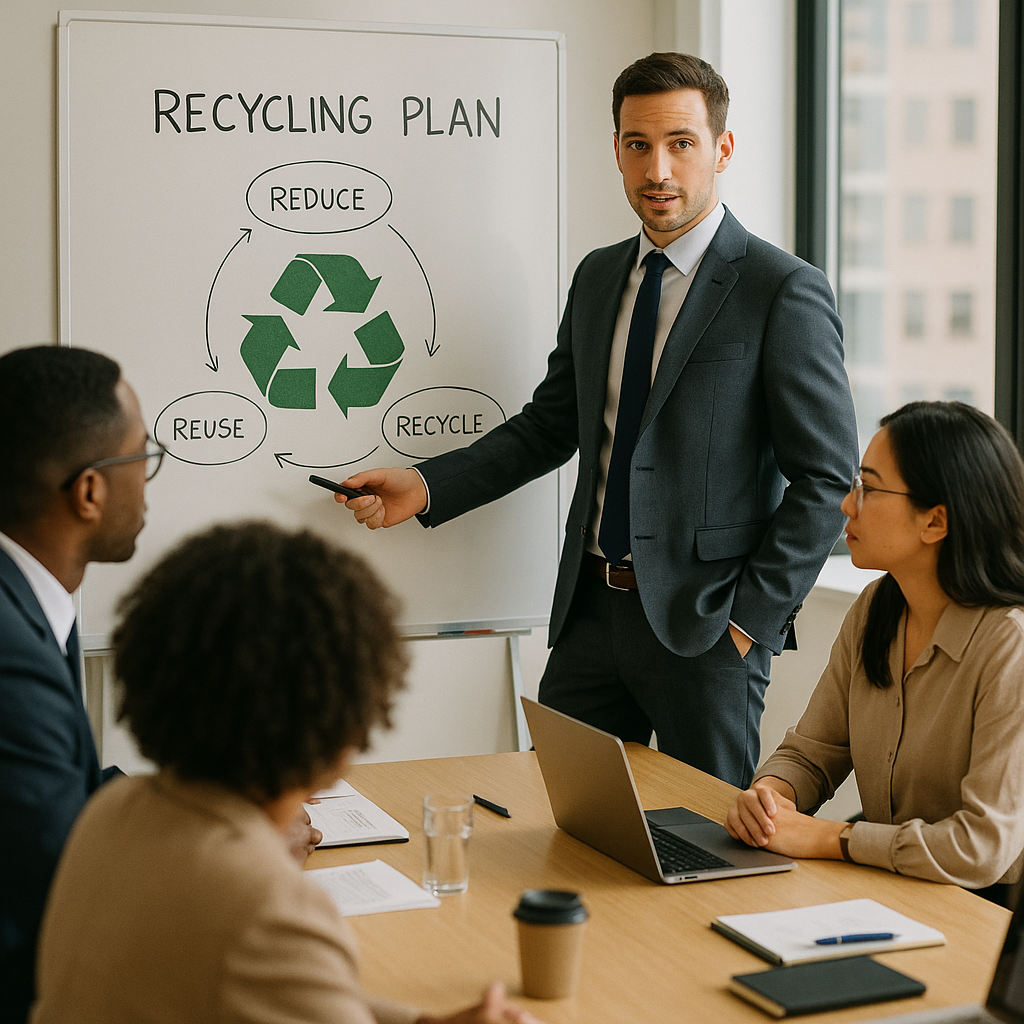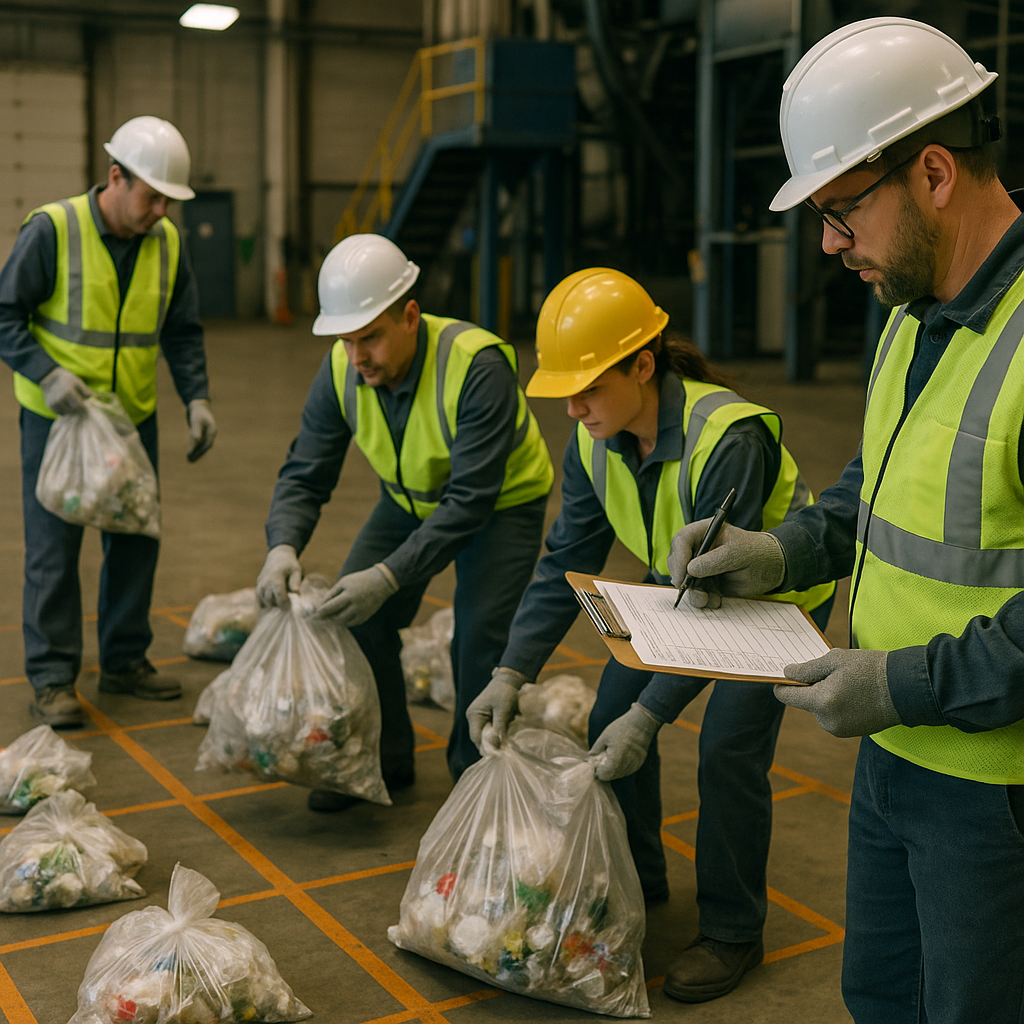5901 Botham Jean Blvd, Dallas, TX 75215
What is a Waste Audit? Key Insights and Benefits
July 12, 2025A waste audit is a formal, structured process that helps organizations understand their waste generation patterns. Essentially, it involves collecting, sorting, and analyzing the waste produced by a business or institution over a specific period. This process reveals exactly what materials are being discarded and in what quantities.
During a waste audit, trained personnel examine the contents of trash bins and recycling containers. They separate materials into categories such as paper, cardboard, plastics, food waste, and metals. Each category is weighed and recorded to create a comprehensive picture of the waste stream.
The hands-on nature of waste audits provides invaluable insights beyond what disposal bills can offer. By directly handling and identifying what is being discarded, organizations can pinpoint opportunities to reduce waste, improve recycling practices, and potentially save on disposal costs.
Why Conduct a Waste Audit?

Waste audits are invaluable diagnostic tools for organizations dedicated to reducing their environmental impact and improving operational efficiency. These systematic assessments provide clear data that can change how businesses manage their waste streams.
For companies facing rising disposal costs, a waste audit reveals exactly what materials are being discarded. Often, it uncovers recyclable materials mistakenly sent to landfills. For example, one university waste audit found that 75% of discarded materials could have been diverted through recycling and composting programs.
Cost Reduction Opportunities
Financial benefits are one of the most compelling reasons to conduct waste audits. The gathered data can lead to substantial cost savings through several channels:
- Reduced waste hauling expenses by decreasing overall waste volume
- Identification of overcharged waste services or unnecessary pickups
- New revenue streams from recyclable materials like cardboard, which can account for up to 50% of retail waste
- Prevention of contamination fines and penalties in regulated areas
Many businesses find they are paying for half-empty bins or unnecessary collections. As municipal solid waste fees increased by over 28% in the last decade, reducing landfill-bound materials translates directly to bottom-line savings.
Supporting Sustainability Initiatives
Waste audits offer quantifiable metrics that significantly support sustainability programs. The data enables organizations to:
- Establish baseline measurements for tracking waste reduction progress
- Set realistic diversion targets based on actual waste composition
- Document improvements for sustainability reporting and certifications
- Identify opportunities for upstream supply chain improvements
Organizations working towards LEED Certification or TRUE Zero Waste Certification require waste audit data as foundational elements of their applications. The detailed insights help create targeted strategies that deliver measurable environmental benefits.
Addressing Regulatory Requirements
The regulatory framework for waste management grows more complex each year. Waste audits help businesses remain compliant with evolving requirements:
- Meeting mandatory recycling and composting ordinances in cities like Seattle and Austin
- Documenting proper disposal of regulated materials
- Preparing for compliance with upcoming legislation
- Avoiding significant fines for improper waste handling
In some jurisdictions, waste audits are explicitly required by law. For instance, San Francisco’s Refuse Separation Ordinance mandates that large waste generators conduct recycling, composting, and trash audits every three years.
Operational Improvements
Beyond direct waste management benefits, audits often uncover opportunities to enhance overall operations:
- Streamlined waste handling procedures that save staff time
- Optimized bin placement and signage to improve sorting accuracy
- Employee engagement opportunities around sustainability initiatives
- Identification of packaging or process changes that reduce waste at the source
These operational insights can trigger broader efficiency improvements throughout an organization, creating benefits beyond waste management.
| Industry | Waste Audit Benefits |
|---|---|
| Manufacturing | High potential for waste volume reduction and recycling, cost savings, compliance with regulatory standards, opportunity for new revenue streams. |
| Retail | Increase in recyclable material recovery, reduction in waste hauling costs, improved segregation processes. |
| Hospitality | Significant reductions in general waste through improved recycling efforts, potential cost savings on waste disposal. |
| Healthcare | Improved waste stream management, especially of hazardous materials, cost reduction in waste services, compliance with stringent regulations. |
Businesses implementing changes based on waste audit findings often see rapid returns on their investment. The combination of cost savings, regulatory compliance, and sustainability progress makes waste audits an essential part of responsible business practice in today’s environmentally-conscious marketplace.
How is a Waste Audit Conducted?

A waste audit provides valuable insight into your organization’s waste stream by systematically examining what you’re discarding. The process involves collecting, sorting, weighing, and analyzing waste to identify opportunities for improved recycling and waste reduction. Here’s a breakdown of how to conduct an effective waste audit.
Step 1: Form a Cross-Functional Team
Assemble a diverse team with representatives from departments such as operations, facilities management, and sustainability. This ensures comprehensive insights and builds organizational buy-in for implementing audit-based changes. Designate specific roles for team members, including sorters, data recorders, and a project coordinator.
Step 2: Set Clear Objectives
Define your objectives for the waste audit. Are you aiming to reduce disposal costs, increase recycling rates, or meet compliance requirements? Clear goals guide your methodology and ensure you collect relevant data. Document these goals and share them with stakeholders to create accountability.
Step 3: Prepare for the Audit
Thorough preparation is crucial. Choose a typical operational week for waste collection to ensure representative data. Notify custodial staff to set aside waste from designated areas. Secure a well-ventilated sorting space with adequate room for your team to work safely and efficiently.
Gather necessary supplies including:
- Personal protective equipment (PPE): N95 masks, tear-resistant gloves, safety goggles, and protective clothing
- Sorting tools: Tarps, tables, tongs, and labeled containers for different waste categories
- Weighing equipment: Digital scales for accurate measurement
- Documentation materials: Clipboards, data sheets, and cameras
Step 4: Collect and Sort Waste
Collect waste from various areas over several days, preferably Tuesday through Thursday when operations are normal. Label bags according to their source location for department-specific insights. Weigh all trash first to establish your baseline total.
Wearing appropriate PPE, carefully sort waste into predetermined categories such as:
- Paper (office paper, newspaper, and magazines)
- Cardboard
- Plastics (separated by type if possible)
- Glass
- Metal (aluminum cans, steel containers)
- Food waste
- Non-recyclable materials
Pay special attention to recyclable materials found in general waste streams, as these represent immediate improvement opportunities.
Step 5: Weigh and Record Data
After sorting, weigh each category separately and record the data. Calculate the percentage each waste type represents of your total waste stream. Document findings with photographs to provide visual evidence of waste composition, which can be powerful for communication.
While auditing, note contamination issues where recyclable streams contain non-recyclable items or vice versa. These insights can identify areas needing better signage or employee education.
Step 6: Analyze Results and Develop Recommendations
Analyze the collected data to identify patterns and opportunities. Calculate your waste diversion rate by dividing the weight of recyclables by the total waste weight and multiplying by 100. Look for simple changes that yield significant improvements, like adding recycling bins in key locations or improving signage.
Step 7: Implement Changes and Monitor Progress
Develop and implement a waste reduction action plan based on your findings, with specific initiatives, clear responsibilities, and measurable targets. Consider conducting follow-up mini-audits quarterly to track progress and make needed adjustments.
Safety Considerations During the Audit
Safety is a top priority throughout the waste audit process. Adhere to these essential safety practices:
- Ensure all team members are properly trained in waste handling procedures
- Consistently enforce the use of appropriate PPE
- Identify and separately manage any hazardous materials according to regulations
- Provide adequate handwashing facilities and sanitizers
- Avoid lifting heavy bags alone; use proper lifting techniques
- Ensure good ventilation in the sorting area to minimize odors and airborne particles
Conducting a waste audit might seem messy, but the insights gained are invaluable for developing effective waste reduction strategies. The data collected provides a solid foundation for measuring progress, identifying cost-saving opportunities, and enhancing your organization’s sustainability performance.
| Personal Protective Equipment (PPE) | Gloves, safety glasses, protective clothing |
| Sorting Tools | Tarps, tables, bins for segregation |
| Measurement Tools | Scales, measuring tape |
| Documentation Supplies | Clipboards, pens, cameras, labels |
| Sanitation Supplies | Hand sanitizer and washing stations |
With proper planning and execution, a waste audit can be the catalyst for significant improvements in your waste management practices, reducing environmental impact and potentially lowering disposal costs.
What Insights Can a Waste Audit Provide?

Waste audits offer valuable insights that can change organizational approaches to waste management. By analyzing the waste stream thoroughly, these audits uncover patterns and opportunities that might be missed during regular operations.
A comprehensive waste audit reveals the precise composition of your waste, indicating what materials exist and in what quantities. This foundational measurement enables informed decision-making rather than speculation on waste generation patterns.
Waste Composition Analysis
The primary insight from a waste audit is a detailed breakdown of waste types by volume and weight. This analysis often shows that a considerable portion of landfill-bound waste could be diverted through recycling or composting programs.
For instance, organizations frequently find that paper and cardboard constitute 30-40% of their waste stream, while food waste might represent 20-25% in facilities with cafeterias. These figures provide clear guidance for targeted waste reduction strategies.
Waste audits also highlight contamination issues in recycling streams. Recyclable materials mixed with non-recyclables can lead to processing facility rejections. Recognizing these contamination points helps improve signage, bin placement, and employee education.
Operational Efficiency Opportunities
Beyond waste composition, audits identify inefficiencies in collection systems. They may reveal that bins are serviced too frequently or not enough, or that certain areas accumulate specific types of waste at higher rates.
Facilities often find that their existing bin configuration doesn’t meet actual disposal needs. For example, an office might have equal-sized bins for all waste streams, while generating three times more recyclables than landfill waste.
These operational insights enable organizations to adjust their waste management systems, placing appropriate containers in optimal locations to maximize diversion and minimize contamination.
Cost Reduction Potential
Waste audits provide concrete financial data by quantifying disposal costs for different materials. By calculating the expense of landfilling recyclable materials, organizations can identify potential savings from improved diversion.
A manufacturing facility that conducted a waste audit discovered they were sending $75,000 worth of reusable materials to landfills annually. By implementing targeted recycling programs, they reduced waste expenses by 52% while developing a new material recovery revenue stream.
Audits also reveal opportunities to negotiate better terms with waste haulers based on actual volume data instead of estimated needs. Many organizations decrease collection frequency after learning their actual fill rates, resulting in immediate savings.
Sustainability Metrics and Reporting
Waste audits establish key performance indicators that aid in sustainability reporting and goal-setting. The waste diversion rate—the percentage of waste kept out of landfills—provides a clear metric to monitor progress over time.
Organizations can calculate their diversion rate by dividing the weight of materials recycled or composted by the total waste generated, then multiplying by 100. This percentage becomes a baseline for evaluating waste reduction efforts.
These metrics support compliance with different certification programs, including LEED, TRUE Zero Waste, and specific industry sustainability frameworks. The data helps organizations demonstrate their commitment to environmental goals while identifying areas for improvement.
Regulatory Compliance Assessment
Waste audits help spot potential compliance issues before they escalate. Many regions have strict regulations for waste disposal, especially for items like electronics, batteries, and hazardous waste.
By cataloging all waste streams, audits can identify items requiring special handling per local regulations. This proactive approach helps organizations avoid costly penalties while ensuring proper disposal of regulated materials.
For example, a healthcare facility’s waste audit revealed unintentional disposal of regulated medical waste in general trash. By addressing this, they avoided potential fines exceeding $13,000 per incident.
Insights from waste audits provide a foundation for developing effective waste management strategies that reduce environmental impact, lower costs, and improve operational efficiency. Understanding your waste gives you the knowledge to effect meaningful change across your organization.
| Benefit | Description |
|---|---|
| Waste Composition Analysis | Identifies the exact composition of waste, allowing targeted waste reduction strategies. |
| Operational Efficiency Opportunities | Reveals inefficiencies in waste collection systems, optimizes bin placement. |
| Cost Reduction Potential | By improving diversion, organizations can save on disposal costs and create new revenue streams. |
| Sustainability Metrics and Reporting | Establishes performance indicators for tracking waste diversion and supports sustainability reporting. |
| Regulatory Compliance Assessment | Identifies compliance issues with waste handling regulations, avoiding potential fines. |
Conclusion: Leveraging Waste Audits for Sustainable Waste Management
Waste audits are essential tools in the modern sustainability toolkit. They provide organizations with clear, actionable data about waste composition and generation patterns. This information helps companies pinpoint inefficiencies, identify recycling opportunities, and develop targeted strategies for waste reduction.
Beyond environmental impact, organizations that implement waste audits often experience significant cost savings through reduced disposal fees, optimized collection schedules, and new revenue streams from recyclable materials. These audits also support regulatory compliance while demonstrating environmental responsibility to stakeholders, customers, and communities.
For your organization’s waste management and recycling needs, contact Okon Recycling at 214-717-4083. Our team can help you conduct a comprehensive waste audit and develop strategies to transform your waste streams into opportunities for sustainability and savings.
